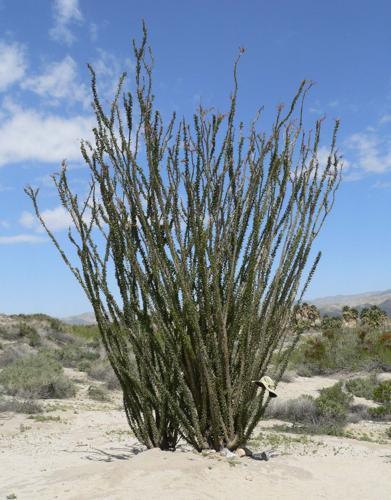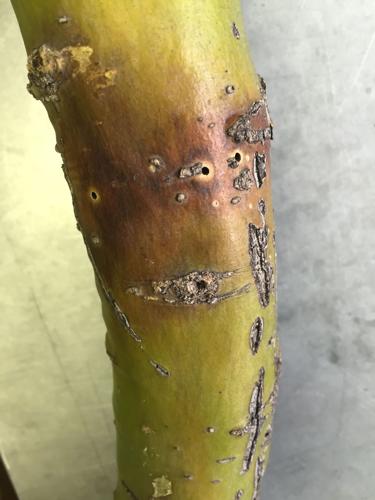Q: About 15-20 years ago my son gave my husband a banana tree that was about 3 feet tall. It sat outside in the hot sun in the summer and in the low 20s in the winter. We live in the Tanque Verde area so we are close to the wash where it does get down to 14 degrees in the winter. The tree languished there until about three years ago.
It was dying, all brown, scaly, and all the leaves were peeling off. I decided that it was either going to die or we had to do something. So we put it into a 3-foot diameter pot with better soil (potting soil mixed with our llama and rabbit poop) and moved it into the “hot tub room.” This is a room with a hot tub and a 15-foot ceiling and windows facing north. So, the banana tree started to grow. Now it is so tall and robust that the leaves are touching the ceiling and it has bananas. I water it about three times a week and it is looking good. My question is, what next?
A: Congratulations on bringing your banana plant back to good health. Bananas in an ideal situation will multiply rapidly and form a grove. Like many plants, they require water, fertilization, and sun. The watering is more critical during the warm months when they are actively growing.
Your well-draining soil and fertilizer are surely helpful as it grows. Our hot desert sun can be too much for young plants, so it is good to protect them. A larger container would allow your plant to grow bigger and spread out. Dividing up the two plants would allow you to keep one inside and put one outside while the weather is warm, if that is appealing.
I’ve seen banana plants in landscapes in Phoenix. There may be some in Tucson, but we are more prone to the occasional frost or freeze and bananas cannot tolerate much cold weather. Keeping it indoors or in a protected area outside is the best we can do here.
Fruiting requires 10 to 15 months of above-freezing temperatures, so keeping it in a greenhouse or in your hot tub room is the best way to grow the fruit. If you plan to keep one outside, be prepared to cover it as we do for citrus and sensitive cacti and succulents if cold temperatures are in the forecast.
Q: I have an ocotillo in my yard that is about 20-feet tall. When it leafs out it does not leaf in the tallest two or three feet. It has not bloomed in several years. What can I do?
A: Your ocotillo is quite large and they don’t grow much taller than that. They also only live about 60 years under ideal conditions. It’s possible that the tallest parts are not receiving nutrients as readily as the lower parts due to age and because it’s a long way to the top.
These are tough desert plants that don’t require much care. Watering is only done sparingly in years when we receive less rain than average and excess water can damage these plants.
In nature, ocotillos do just fine without fertilizer in soils that have very little organic matter. If you want to try giving it a little slow-release fertilizer in early summer in the form of compost, that wouldn’t do any harm as long as you don’t overdo it. Distributing a half-inch of compost over the root zone and lightly watering it in is the most you would need.
Q: The bark of my palo verde tree had yellow-orange blotches on it about six inches in length just about everywhere. I noticed that there is a hole in what looks to be the center of each of these blotches. It looks as though something has either bored into or out of the tree. The bore diameter is around 1/16th of an inch.
1. Is there any chance of salvaging the tree?
2. I have another palo verde around 10 feet from the effected one that shares the same canopy. Is the second palo verde at risk? If so, what can I do to minimize contamination?
3. The trees are in the same wash are the same age and share a microclimate. Are there any reasons why one was affected?
4. Is there anything I can do to ensure that if I do lose the one tree I will not lose any more?
A: The beetles were identified by Gene Hall of the University of Arizona Entomology Department as Trogoxylon prostomoides, a type of wood-boring beetle found in a variety of dead and dying trees. They are not the cause of death, but rather a decomposer species that is attracted to the tree by way of chemical cues the tree gives off as it dies.
There is nothing to do to manage the beetles because they are endemic to the area. However, you can manage the health of nearby trees to make them less susceptible to attack. This mainly includes sufficient watering for desert species such as palo verde trees. Desert trees need a good soak every two to three weeks during the spring, summer, and fall to a depth of 24 to 36 inches.
These beetles have been found in other desert legume species in the plant family Fabaceae such as mesquite. This family includes many native Sonoran Desert trees and they are all known for their drought tolerance but long-term drought conditions can be hard on even the toughest plants.





